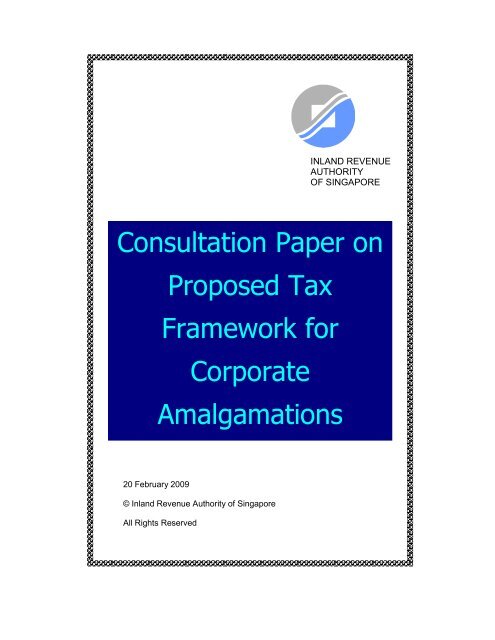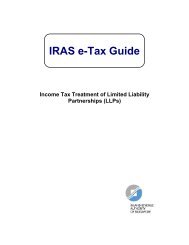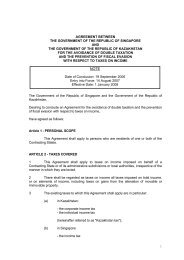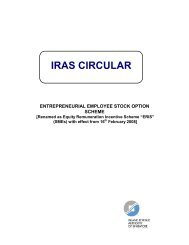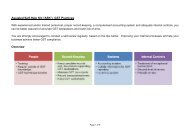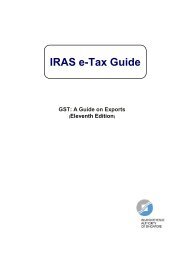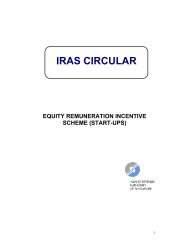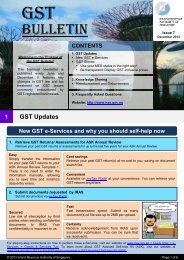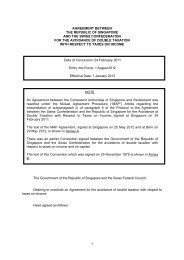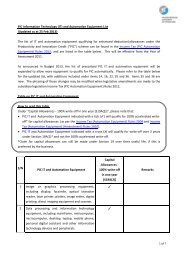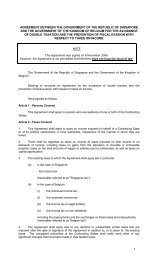Tax Framework for Corporate Amalgamations - IRAS
Tax Framework for Corporate Amalgamations - IRAS
Tax Framework for Corporate Amalgamations - IRAS
You also want an ePaper? Increase the reach of your titles
YUMPU automatically turns print PDFs into web optimized ePapers that Google loves.
INLAND REVENUE<br />
AUTHORITY<br />
OF SINGAPORE<br />
Consultation Paper on<br />
Proposed <strong>Tax</strong><br />
<strong>Framework</strong> <strong>for</strong><br />
<strong>Corporate</strong><br />
<strong>Amalgamations</strong><br />
20 February 2009<br />
© Inland Revenue Authority of Singapore<br />
All Rights Reserved
Consultation Paper on Proposed <strong>Tax</strong> <strong>Framework</strong> <strong>for</strong> <strong>Corporate</strong> <strong>Amalgamations</strong><br />
CONSULTATION PAPER ON PROPOSED TAX FRAMEWORK FOR<br />
CORPORATE AMALGAMATIONS<br />
1 INVITATION TO COMMENT<br />
1.1 To facilitate companies in restructuring and rationalising their businesses,<br />
it was announced in Budget 2009 that a new tax framework <strong>for</strong> qualifying<br />
corporate amalgamations will be introduced. This consultation paper sets<br />
out the details of the proposed tax framework.<br />
1.2 We welcome feedback from the public on the proposed tax framework <strong>for</strong><br />
corporate amalgamations. In particular, we seek feedback on the<br />
following questions:<br />
a) What are the issues and concerns that amalgamating companies<br />
and amalgamated company may face if the tax framework is<br />
adopted. Please include suggestions to modify the proposed tax<br />
framework to address the issues highlighted by you. Please also<br />
explain the basis of the modifications suggested by you.<br />
b) What further measures which the Government should consider<br />
implementing to prevent potential abuses of companies seeking to<br />
monetize tax assets under the tax framework (please refer to<br />
paragraph 5.8.3).<br />
2 Submission<br />
2.1 Your comments are most useful if you indicate the specific paragraph to<br />
which they relate. To facilitate the review, please submit clear and<br />
succinct comments of preferably no more than 4 pages in length.<br />
2.2 The closing date <strong>for</strong> submission of your views and comments is 20 March<br />
2009. Your submission should include your name, the organisation you<br />
work <strong>for</strong> or represent, your email address and telephone number and be<br />
addressed to:<br />
Comptroller of Income <strong>Tax</strong><br />
Inland Revenue Authority of Singapore<br />
<strong>Tax</strong> Policy & Rulings Branch<br />
55 Newton Road<br />
Singapore 307987<br />
Or email to:<br />
Public_Consultation@iras.gov.sg<br />
2.3 We reserve the right to make public all or parts of any written submissions<br />
made in response to this Consultation Paper and to disclose the identity of<br />
the contributor. All views and comments received will be considered.<br />
2 of 16
Consultation Paper on Proposed <strong>Tax</strong> <strong>Framework</strong> <strong>for</strong> <strong>Corporate</strong> <strong>Amalgamations</strong><br />
1 Background<br />
1.1 The Companies (Amendment) Act 2005 introduced a new method of<br />
carrying out mergers or amalgamations where companies can<br />
amalgamate without having to first obtain court approval. This <strong>for</strong>m of<br />
amalgamation (hereinafter referred to as “statutory voluntary<br />
amalgamations”) is provided <strong>for</strong> in Sections 215B to 215G of the<br />
Companies Act and took effect from 30 January 2006.<br />
1.2 A statutory voluntary amalgamation envisages the continuation of the<br />
amalgamating companies as one single company, which may be a new<br />
company or one of the amalgamating companies (hereinafter referred to<br />
as “amalgamated company”). The significant legal implication upon such<br />
an amalgamation is that all property, rights, privileges, liabilities and<br />
obligations, etc. of each of the amalgamating companies will be<br />
transferred to and assumed by the amalgamated company. Shareholders<br />
of the amalgamating companies may or may not become shareholders of<br />
the amalgamated company.<br />
1.3 A statutory voluntary amalgamation takes effect on the date specified in<br />
the Notice of Amalgamation issued by the Registrar of Companies. On<br />
that day, all the assets, liabilities, property, rights, powers and privileges of<br />
the amalgamating companies are vested in the amalgamated company.<br />
The amalgamated company will have its name registered (if it is newly<br />
incorporated) and all of the amalgamating companies except the surviving<br />
company, where applicable, will be removed from the register of<br />
companies.<br />
1.4 A statutory voluntary amalgamation is different from the existing two basic<br />
methods of mergers and acquisitions (“M&A”) –<br />
(i)<br />
acquisition of assets in a targeted company where the targeted<br />
company remains after the disposal of its assets; and<br />
(ii)<br />
acquisition of shares in a targeted company where the shareholders<br />
of the targeted company sell their shares to the purchasing<br />
company and the targeted company becomes a subsidiary of the<br />
purchasing company thereafter.<br />
1.5 In a statutory voluntary amalgamation, only one company remains or is<br />
<strong>for</strong>med upon completion of the amalgamation process.<br />
2 Current <strong>Tax</strong> Treatment <strong>for</strong> <strong>Corporate</strong> <strong>Amalgamations</strong><br />
2.1 Currently, <strong>for</strong> income tax purposes, amalgamating companies are treated<br />
as having ceased businesses and disposed of their assets and liabilities<br />
and the amalgamated company having acquired or commenced a new<br />
business. This treatment may give rise to taxable gains in the hands of<br />
3 of 16
Consultation Paper on Proposed <strong>Tax</strong> <strong>Framework</strong> <strong>for</strong> <strong>Corporate</strong> <strong>Amalgamations</strong><br />
the amalgamating companies because trading stocks 1 and certain assets 2<br />
are subject to tax based on either the transfer price or open market values.<br />
Balancing allowance or charge on plant and machinery or industrial<br />
buildings will also have to be accounted <strong>for</strong> upon disposal, unless the<br />
companies involved in the amalgamation are eligible to make an election<br />
under Section 24 of the Singapore Income <strong>Tax</strong> Act (“ITA”).<br />
3 Proposed <strong>Tax</strong> <strong>Framework</strong> <strong>for</strong> <strong>Corporate</strong> <strong>Amalgamations</strong><br />
3.1 To minimise the tax consequences arising from amalgamations, a new tax<br />
framework <strong>for</strong> specified statutory amalgamations (hereinafter referred to<br />
as “qualifying statutory amalgamations”), is proposed. The proposed tax<br />
framework recognises the consequences as provided in the Companies<br />
Act <strong>for</strong> such qualifying statutory amalgamations and gives effect by<br />
aligning the consequential tax treatments <strong>for</strong> amalgamations.<br />
3.2 The proposed tax framework is intended to give tax effect to qualifying<br />
statutory amalgamations as if there is no cessation of the existing<br />
businesses by the amalgamating companies (and hence no acquisition of<br />
new businesses by the amalgamated company) and all risks and benefits<br />
that exist prior to the merger are transferred and vested in the<br />
amalgamated company. In other words, under the proposed tax<br />
framework, qualifying statutory amalgamations will be treated as a<br />
continuation of the existing businesses of the amalgamating companies by<br />
the amalgamated company. On the date of amalgamation, i.e., the date<br />
shown in a notice of amalgamation or a court order, the amalgamated<br />
company would be treated as having “stepped into the shoes” of the<br />
amalgamating companies and continued with the business(es)<br />
seamlessly.<br />
3.3 Under the proposed tax framework, the intention is to ensure that most of<br />
the tax consequences of a continuing business will apply to the<br />
amalgamated company. Hence, the tax treatment of provisions, trading<br />
stocks, capital allowances, accruals, prepayments etc., transferred to the<br />
amalgamated company from the amalgamating companies, will be<br />
ascertained on the basis that the businesses that have been taken over<br />
entirely have not ceased but continue in the amalgamated company, as<br />
part of the business (or enlarged business) of the amalgamated company.<br />
4 Definition of Qualifying Statutory Amalgamation<br />
4.1 For the purposes of the proposed tax framework, a qualifying statutory<br />
amalgamation is one that is carried out in accordance with sections 215B<br />
to 215G of the Companies Act, and satisfies the following conditions:<br />
1 This is provided <strong>for</strong> under Section 32 of the ITA.<br />
2 The taxability of gains from the disposal of certain non-trading stocks is determined based on<br />
the badges of trade.<br />
4 of 16
Consultation Paper on Proposed <strong>Tax</strong> <strong>Framework</strong> <strong>for</strong> <strong>Corporate</strong> <strong>Amalgamations</strong><br />
(i)<br />
(ii)<br />
(iii)<br />
all the amalgamating companies must be tax residents of Singapore<br />
be<strong>for</strong>e the amalgamation;<br />
the amalgamated company must be a tax resident of Singapore<br />
after the amalgamation; and<br />
on the day of amalgamation 3 , the amalgamated company intends to<br />
continue the business(es) of the amalgamating companies as part<br />
of the amalgamated company’s business or enlarged business.<br />
4.2 Where the amalgamation is a court-directed or approved amalgamation<br />
under the Companies Act or Banking Act, the proposed tax framework<br />
may still be made available to the companies, provided the amalgamation<br />
has a similar effect as that of a voluntary amalgamation under sections<br />
215B to 215G of the Companies Act, and the conditions in paragraph<br />
4.1(i) to (iii) are satisfied.<br />
5 <strong>Tax</strong> Treatment of Specific Assets, Liabilities and <strong>Tax</strong> Items<br />
5.1 The proposed tax treatment <strong>for</strong> certain specific assets, liabilities and tax<br />
items transferred under a qualifying statutory amalgamation is provided in<br />
the Annex 4 . Some of these items are highlighted below.<br />
5.2 Plant & Machinery (“P&M”) and Industrial Buildings (“IB”)<br />
In respect of P&M and IB where capital allowances have been claimed,<br />
the amalgamated company will be allowed to continue to claim capital<br />
allowances on the assets transferred based on tax written down value of<br />
the assets taken over. The amalgamating companies and the<br />
amalgamated company will be deemed to have made an election under<br />
section 24 of the ITA even if the companies are not related. As such, the<br />
transfer will not give rise to a balancing allowance or a balancing charge at<br />
the point of amalgamation. Balancing adjustments will only be made to<br />
the amalgamated company when it subsequently disposes of the assets or<br />
when its business permanently ceases.<br />
5.3 Intellectual Property Rights (“IPR”)<br />
5.3.1 In respect of IPR, the amalgamated company will be allowed to continue to<br />
claim writing down allowances under section 19B of the ITA based on the<br />
tax written down amount of the rights taken over. As such, the transfer will<br />
3<br />
If the amalgamated company were to subsequently change its intention concerning the<br />
business(es) taken over or assets pertaining to the business(es) taken over, normal tax rules will<br />
apply to determine any tax consequences that may arise from such a change of intention at the<br />
time when the intention changes.<br />
4 The Annex covers assets, liabilities and tax items commonly encountered in amalgamations of<br />
companies in general. Although not covered in this paper, the tax treatment <strong>for</strong> items transferred<br />
in amalgamations involving companies in specialised industries (e.g., banks and insurance<br />
companies) will generally follow the principles set out in paragraphs 3.1 to 3.3 above.<br />
5 of 16
Consultation Paper on Proposed <strong>Tax</strong> <strong>Framework</strong> <strong>for</strong> <strong>Corporate</strong> <strong>Amalgamations</strong><br />
not give rise to a charge under section 19B(5).<br />
5.3.2 Where, as a result of the amalgamation, IPRs (or intangible assets) are<br />
required to be recognised in the balance sheet of the amalgamated<br />
company in accordance with the requirements of Financial Reporting<br />
Standard (“FRS”) 103 – Business Combinations, no writing down<br />
allowances would be allowed on these rights recognised by the<br />
amalgamated company <strong>for</strong> financial reporting purposes. This applies<br />
whether the transfer is made between related parties or not. This is<br />
consistent with the concept underlying the new tax framework which<br />
regards the amalgamated company as a continuation of the amalgamating<br />
companies. As such, no new IPRs should be regarded as being acquired<br />
or created in the amalgamation process.<br />
5.4 Assets on Capital Accounts<br />
5.4.1 For the purpose of determining the appropriate tax treatment <strong>for</strong> disposals<br />
of assets subsequent to the amalgamation (e.g. whether the disposal is<br />
capital or revenue in nature, whether there has been a change in intention<br />
<strong>for</strong> the acquisition of the asset, etc.), the amalgamated company will be<br />
deemed to have held the relevant asset from the date the asset was first<br />
acquired by the amalgamating company. The gain or loss on disposal will<br />
be computed based on the original cost incurred by the amalgamating<br />
companies and not on the fair value of the asset as at the date of transfer.<br />
This is consistent with the proposal to allow the amalgamated company to<br />
continue claiming capital allowances on the assets taken over based on<br />
their tax written down value.<br />
5.4.2 Where the amalgamated company intends to continue holding assets<br />
taken over as capital assets, it should maintain a list of these items as at<br />
the date of amalgamation. Details that should be kept on the assets<br />
include:<br />
(i)<br />
(ii)<br />
(iii)<br />
(iv)<br />
(v)<br />
(vi)<br />
Description of the asset;<br />
Date of purchase by the amalgamating companies;<br />
Original cost of asset;<br />
How the asset was financed;<br />
Purpose of the acquisition by the amalgamating companies,<br />
together with supporting evidence; and<br />
Basis <strong>for</strong> claiming that the assets are on capital account.<br />
5.5 Assets on revenue account<br />
5.5.1 Assets on revenue accounts will be transferred, <strong>for</strong> tax purposes, at the<br />
carrying amounts (i.e. the net book values), as reflected in the<br />
amalgamating companies’ books at the point of amalgamation. This is on<br />
the basis that the amalgamated company is treated as having stepped into<br />
the shoes of the amalgamating companies and continued with the<br />
business(es).<br />
6 of 16
Consultation Paper on Proposed <strong>Tax</strong> <strong>Framework</strong> <strong>for</strong> <strong>Corporate</strong> <strong>Amalgamations</strong><br />
5.5.2 Hence, in the case of inventory or trading stocks, the amalgamated<br />
company will be deemed, <strong>for</strong> tax purposes, to have taken over the trading<br />
stocks of the amalgamating companies at their net book value (“NBV”),<br />
which, based on FRS 2 – Inventories, will be the lower of cost and the net<br />
realisable value. Consequently, the cost of the trading stocks that may be<br />
claimed as deduction by the amalgamated company in computing the<br />
gains or profits of its business is the NBV of the trading stocks taken over<br />
at the point of amalgamation.<br />
5.5.3 We understand, however, that the accounting of amalgamations between<br />
unrelated companies is governed by FRS 103 – Business Combinations.<br />
<strong>Amalgamations</strong> within the scope of FRS 103 have to be accounted <strong>for</strong><br />
using the “purchase method”, where all items taken over should be<br />
reflected at fair value (“FV”). Hence, where the FV of the stocks taken<br />
over is higher than its NBV, the amalgamated company is required to track<br />
the NBV of the trading stocks until the stocks are sold, <strong>for</strong> the purposes of<br />
computing the gains or profits of its business. Furthermore, if there is<br />
subsequent diminution in the value of the trading stocks taken over, only<br />
the amount of write-down below the NBV of the stocks taken over at the<br />
point of amalgamation will be allowed as a deduction to the amalgamated<br />
company.<br />
5.5.4 To eliminate the need <strong>for</strong> the amalgamated company to track the NBV of<br />
the trading stocks taken over from the amalgamating companies until the<br />
day the stocks are sold, the amalgamated company will be given the<br />
option to take over the stocks at their FV. The amalgamating companies,<br />
on the other hand, will be deemed to have sold their stocks at the same<br />
FV as reflected in the amalgamated company’s books. Where the FV<br />
exceeds the NBV of the trading stocks, the difference will be brought to tax<br />
in the hands of the relevant amalgamating company at the point of<br />
amalgamation. This option, once elected, will be irrevocable and must<br />
apply to all trading stocks taken over by the amalgamated company.<br />
Change of Intention<br />
5.5.5 There may be instances where assets originally held as trading stocks by<br />
an amalgamating company are to be reclassified as capital assets (e.g.<br />
investments) in the accounts of the amalgamated company at the point of<br />
amalgamation. Once a change in intention is clearly established, the<br />
trading stocks are deemed to have been sold by the amalgamating<br />
company at the open market value upon amalgamation. The<br />
amalgamating company has to account <strong>for</strong> the gain or loss of trading stock<br />
at the point of amalgamation. This is consistent with the current tax<br />
treatment applied to assets when there is a change in intention of the use<br />
of the assets.<br />
5.5.6 Conversely, where investment assets of an amalgamating company<br />
become the trading stocks of the amalgamated company at the point of<br />
amalgamation, the open market value of the assets upon amalgamation<br />
will be adopted as the cost of trading stocks in the hands of the<br />
7 of 16
Consultation Paper on Proposed <strong>Tax</strong> <strong>Framework</strong> <strong>for</strong> <strong>Corporate</strong> <strong>Amalgamations</strong><br />
amalgamated company <strong>for</strong> the purpose of computing gains or profits of its<br />
business when the stocks are subsequently disposed of.<br />
5.6 Bad Debts, contingent losses, etc.<br />
5.6.1 The amalgamated company will be entitled to a deduction <strong>for</strong> impairment<br />
of trading debts taken over, and <strong>for</strong> expenditure or loss arising from the<br />
activities of an amalgamating company be<strong>for</strong>e a qualifying amalgamation,<br />
if a deduction would have been available to the amalgamating company if<br />
it had continued to exist. All subsequent recoveries by the amalgamated<br />
company will be taxable (even in respect of bad debts or specific<br />
provisions previously allowed to the amalgamating company).<br />
5.7 Deduction of interest and related borrowing costs<br />
5.7.1 Interest or borrowing cost is deductible against a particular item of income<br />
only if a direct nexus exists between the money borrowed and that income<br />
item. This is a requirement under Section 14(1)(a) of the ITA. This<br />
requirement remains <strong>for</strong> amalgamated companies seeking to claim a<br />
deduction of interest or borrowing cost in respect of any loan taken over<br />
from the amalgamating companies.<br />
5.7.2 For example, if a company takes up a loan to purchase shares in another<br />
company and the two companies subsequently amalgamate in accordance<br />
with sections 215B to 215G of the Companies Act, the interest expense or<br />
borrowing costs incurred on acquiring the shares in the second-mentioned<br />
company will not be available <strong>for</strong> deduction against the taxable income of<br />
the amalgamated company. This is because there no longer exists a<br />
direct link between the money borrowed (<strong>for</strong> the purpose of share<br />
acquisition) and the income of the amalgamated company.<br />
5.7.3 On the other hand, if the loan taken up by the amalgamating company was<br />
<strong>for</strong> the purchase of a capital asset (e.g., investment property) that is<br />
transferred to the amalgamated company, the interest incurred by the<br />
amalgamated company on that loan will continue to be allowed a<br />
deduction against the income produced by the capital asset after<br />
amalgamation.<br />
5.8 Unabsorbed Capital Allowances, Losses and Donations<br />
5.8.1 The eligibility of utilisation of these unabsorbed items by the amalgamated<br />
company will continue to be governed by the shareholding test as well as<br />
the business continuity test <strong>for</strong> capital allowances and the 5-year carried<br />
<strong>for</strong>ward limitation in the case of donations. The shareholding test was<br />
introduced to ensure that unabsorbed tax losses and capital allowances<br />
are not monetised through the acquisition of loss making companies.<br />
Where a substantial change in shareholding occurs pursuant to a M&A<br />
transaction, the avenue <strong>for</strong> waiver of shareholding test is currently<br />
available under sections 37(16) and 23(5) of the ITA <strong>for</strong> a M&A that is not<br />
motivated by tax reasons and undertaken <strong>for</strong> commercial reasons.<br />
8 of 16
Consultation Paper on Proposed <strong>Tax</strong> <strong>Framework</strong> <strong>for</strong> <strong>Corporate</strong> <strong>Amalgamations</strong><br />
5.8.2 Where the business of an amalgamating company is transferred to a new<br />
company, sections 37(5) and 23(2) of the Income <strong>Tax</strong> Act are not<br />
applicable. This is because the unabsorbed items cannot be transferred<br />
between different legal entities. The amalgamated company will also not<br />
be able to carry back unabsorbed capital allowances and losses as the<br />
amalgamating company (unless it becomes the surviving amalgamated<br />
company) will be wound up and de-registered after the amalgamation.<br />
Nonetheless, to facilitate corporate amalgamations, the utilisation of such<br />
unabsorbed items across entities may be allowed if the corporate<br />
amalgamations are undertaken <strong>for</strong> commercial reasons and are not taxmotivated.<br />
The following conditions will apply:<br />
(i)<br />
(ii)<br />
(iii)<br />
The amalgamating company must be carrying on an active trade or<br />
business and is not dormant at the point of amalgamation;<br />
The amalgamated company continues to carry on the same trade or<br />
business as the amalgamating company from which the<br />
unabsorbed items were transferred; and<br />
The shareholding test requirements, similar to that under Sections<br />
37(12) and 23(4) of the ITA are met unless a waiver by the<br />
Comptroller is granted 5 ;<br />
5.8.3 Other than the conditions above, the government may impose further<br />
conditions with the view to prevent monetisation of unabsorbed tax assets<br />
of the amalgamating companies.<br />
5.9 Unremitted Foreign-Sourced Income<br />
5.9.1 Foreign-sourced income of the amalgamating companies will not be<br />
deemed as having been remitted to Singapore upon amalgamation as long<br />
as the income continue to remain outside Singapore at the point of<br />
amalgamation. The <strong>for</strong>eign-sourced income would be considered as<br />
remitted by the amalgamated company to Singapore when it subsequently<br />
falls within one of the situations mentioned under section 10(25)(a) to (c)<br />
of the ITA.<br />
5.10 <strong>Tax</strong> Incentives<br />
5.10.1 <strong>Tax</strong> incentives enjoyed by the amalgamating companies which will be<br />
terminated upon amalgamation may, subject to the agreement of the<br />
relevant economic promoting agencies, be accorded or transferred to the<br />
amalgamated company. Once approval is granted by the relevant<br />
5 To illustrate the application of the shareholding test across entities, say <strong>for</strong> example, Company A<br />
(“A”) amalgamates with Company B (“B”) to <strong>for</strong>m a new entity, Company C (“C”). A has<br />
unabsorbed losses at the point of amalgamation. The shareholding test requirements will be met<br />
if the ultimate shareholders of C on the first day of the year of assessment that it wishes to utilise<br />
the losses of A are substantially the same as the ultimate shareholders of A on the last day of the<br />
year in which the loss was incurred.<br />
9 of 16
Consultation Paper on Proposed <strong>Tax</strong> <strong>Framework</strong> <strong>for</strong> <strong>Corporate</strong> <strong>Amalgamations</strong><br />
economic promoting agency <strong>for</strong> the transfer of tax incentive, the<br />
amalgamated company would continue to enjoy the concessionary rates<br />
or exemption <strong>for</strong> the specified incentivised income streams, as well as to<br />
utilise any balance of the investment allowance that have not been utilised<br />
by the amalgamating companies.<br />
5.10.2 Companies accorded tax incentives should approach the relevant<br />
economic agencies and <strong>IRAS</strong> prior to any proposed amalgamation so that<br />
the transfer or modification of the incentives could be considered.<br />
5.11 <strong>Tax</strong> Payable/ Refunds<br />
5.11.1 Under section 215G of the Companies Act, the amalgamated company will<br />
assume all liabilities and obligations of the amalgamating companies,<br />
including tax liabilities and obligations. Accordingly, where any<br />
outstanding tax liabilities or obligations of the amalgamating companies<br />
are not discharged prior to the date of amalgamation, the amalgamated<br />
company will have to assume and discharge all outstanding tax liabilities<br />
and obligations of the amalgamating companies.<br />
5.12 FRS 39 <strong>Tax</strong> Treatment<br />
5.12.1 Where the amalgamating companies have previously elected to remain on<br />
the pre-FRS 39 tax treatment, the amalgamated company will retain the<br />
pre-FRS 39 tax treatment unless it opts to move to the FRS 39 tax<br />
treatment 6 .<br />
5.12.2 On the other hand, if any of the amalgamating companies have previously<br />
adopted the FRS 39 tax treatment, then the amalgamated company will<br />
not be allowed to opt out of the FRS 39 tax treatment. In this case, the<br />
gains or losses arising from the transitional tax adjustments to the financial<br />
assets and liabilities of the amalgamating company that was on the pre-<br />
FRS 39 tax treatment (as described in paragraphs 20 to 22 of <strong>IRAS</strong>’<br />
circular “Income <strong>Tax</strong> Implications arising from the adoption of FRS 39 –<br />
Financial Instruments: Recognition & Measurement” published on 8 March<br />
2006) will be taxed as the income of the amalgamated company, or<br />
allowed as a deduction against its income.<br />
5.13 Goods and Services <strong>Tax</strong> (GST)<br />
5.13.1 No GST will be imposed in qualifying statutory amalgamations where the<br />
same conditions <strong>for</strong> GST exclusion as in the transfers of going concerns 7<br />
are met.<br />
6<br />
For details on FRS 39 (as well as pre-FRS 39) tax treatment, please refer to refer to <strong>IRAS</strong> e-<br />
<strong>Tax</strong> guide on “Income tax implications arising from the adoption of FRS 39 – Financial<br />
Instruments: Recognition & Measurement” published on 8 March 2006.<br />
7 Under GST (Excluded Transactions) Order<br />
10 of 16
Consultation Paper on Proposed <strong>Tax</strong> <strong>Framework</strong> <strong>for</strong> <strong>Corporate</strong> <strong>Amalgamations</strong><br />
5.14 Stamp Duty<br />
5.14.1 Stamp Duties Relief is available if the qualifying statutory amalgamation<br />
satisfies the Stamp Duties (Reconstruction or Amalgamation of<br />
Companies) Rules.<br />
6 Implementation<br />
6.1 It is proposed that the new tax framework will apply to qualifying statutory<br />
amalgamations that take place on or after Budget Day i.e. 22 January<br />
2009. All other <strong>for</strong>ms of M&A not falling within the scope of qualifying<br />
statutory amalgamation will be subject to the current tax rules and<br />
treatment.<br />
11 of 16
Consultation Paper on Proposed <strong>Tax</strong> <strong>Framework</strong> <strong>for</strong> <strong>Corporate</strong> <strong>Amalgamations</strong><br />
Annex<br />
Summary of proposed tax treatment <strong>for</strong> assets, liabilities and tax items transferred under a qualifying statutory amalgamation in Singapore.<br />
The summary below covers only assets, liabilities and tax items commonly encountered in amalgamations of companies in general. The tax treatment<br />
<strong>for</strong> items not covered in this summary will generally follow the principles set out in paragraphs 3.1 to 3.3 of the main consultation paper.<br />
S/N<br />
Item and specific<br />
provisions in ITA<br />
Proposed tax treatment<br />
(<strong>for</strong> qualifying statutory amalgamations only)<br />
A<br />
Accounting items<br />
1 Trading stocks (inventories) The amalgamated company, in computing its profits, may claim a deduction <strong>for</strong> the cost of the trading stocks, which will be<br />
the NBV (i.e. the lower of cost or net realisable value) of the stocks as reflected in the amalgamating company’s books at the<br />
point of transfer. This is on the basis that the amalgamated company is treated as having stepped into the shoes of the<br />
amalgamating company and continued with the business.<br />
However, to eliminate the need <strong>for</strong> the amalgamated company to track the NBV of the trading stocks taken over from the<br />
amalgamating company until the stocks are sold, the amalgamated company will be given the option to take over the stocks<br />
at their fair value (“FV”) as reflected in its books. Under this option, the amalgamating company will then be deemed to have<br />
sold its stocks at the same FV as reflected in the amalgamated company’s books. Any gains arising from the difference in the<br />
FV and NBV of the stocks will be taxed in the hands of the amalgamating company at the point of amalgamation.<br />
2 Bad debts and specific<br />
provision <strong>for</strong> doubtful debts<br />
(trade debts)<br />
3 Provision <strong>for</strong> stock<br />
obsolescence<br />
4 Provisions (e.g. staff<br />
retirement and pension fund,<br />
retrenchment benefits,<br />
warranty expenses)<br />
Where the trade debts taken over subsequently become bad, doubtful or impaired, a claim <strong>for</strong> deduction by the amalgamated<br />
company would be allowed. All subsequent recoveries by the amalgamated company (including those in respect of bad or<br />
doubtful debts or impairments previously allowed to the amalgamating company) would be taxable.<br />
Since provisions or impairment are generally already allowed to the amalgamating company as and when the provisions were<br />
made, the question of the amalgamated company claiming deduction <strong>for</strong> such provisions or impairment should not arise in<br />
most cases (the amalgamated company may however claim additional provision after the amalgamation). All subsequent<br />
write-backs of any provisions previously allowed tax deduction would be taxable in the hands of the amalgamated company.<br />
Such provisions are generally not allowable as deduction to the amalgamated company as the liability has not crystalised at<br />
the point of amalgamation but will only arise in the future. A claim by the amalgamated company <strong>for</strong> payments made out of<br />
provisions taken over will be allowable if the expenses are wholly and exclusively incurred in the production of its income.<br />
Any write-backs (including on those expenses allowed to the amalgamating company previously) would be taxable in the<br />
hands of the amalgamated company.<br />
12 of 16
Consultation Paper on Proposed <strong>Tax</strong> <strong>Framework</strong> <strong>for</strong> <strong>Corporate</strong> <strong>Amalgamations</strong><br />
Annex<br />
S/N<br />
Item and specific<br />
provisions in ITA<br />
Proposed tax treatment<br />
(<strong>for</strong> qualifying statutory amalgamations only)<br />
5 Prepayments The prepayments will not be allowable as a deduction to the amalgamated company in the year the payments are made since<br />
they are not regarded as expenses incurred <strong>for</strong> the purposes of section 14(1) of the Income <strong>Tax</strong> Act (“ITA”). The<br />
amalgamated company will be allowed a claim <strong>for</strong> deduction as and when the expenses are incurred in the production of its<br />
income.<br />
6 Accruals/ payables Such accruals/ payables are generally already allowed as a deduction to the amalgamating company as and when the<br />
expenses were incurred in the production of its income. If a deduction has already been given to the amalgamating<br />
company, no deduction will be given again to the amalgamated company. Any write-backs will be taxable in the hands of the<br />
amalgamated company.<br />
7 Trade receivables Since the income would have already been subject to tax in the hands of the amalgamating company, the amalgamated<br />
company will not be taxed on the same amount again. The claim <strong>for</strong> bad/doubtful debts is addressed in item 2 above.<br />
8 Income received in advance Since the income would not have been taxed in the hands of the amalgamating company because the income has not been<br />
earned yet, the amalgamated company will be taxed on the income when it is earned <strong>for</strong> tax purposes.<br />
9 Other assets (properties and<br />
investment in shares on<br />
capital account, etc.)<br />
10 Intellectual Property Rights<br />
(“IPR”)<br />
The transfer will not be treated as if it was a purchase or sale. In determining the appropriate tax treatment <strong>for</strong> disposal<br />
events occurring after the amalgamation (e.g. whether disposal is capital or revenue, whether there is a change in intention<br />
etc.), the amalgamated company will be assessed as if it had been operating the same business all this while (i.e. stepped<br />
into the shoes of the amalgamating company). The gain or loss on disposal, if any, will be computed based on original cost<br />
incurred by the amalgamating company and not the open market value or FV of the asset as at the date of transfer. This<br />
means that the amalgamated company must keep a record of the details of each of these items transferred at the point of<br />
amalgamation.<br />
No writing down allowance will be given in respect of IPR recognised upon amalgamation* unless the IPR is an existing asset<br />
of the amalgamating company be<strong>for</strong>e the amalgamation and is taken over as part of the transfer of business. This applies<br />
whether the amalgamation involves related parties or not. This is on the basis that the amalgamated company is a<br />
continuation of the amalgamating company and as such, no new IPRs can be regarded as being acquired or created in the<br />
amalgamation process.<br />
*Note: The “purchase method” under FRS103 may require IPRs to be recognized in the balance sheet of the amalgamated<br />
company upon amalgamation if certain conditions are satisfied even if the IPRs did not previously exist in the amalgamating<br />
company’s books.<br />
13 of 16
Consultation Paper on Proposed <strong>Tax</strong> <strong>Framework</strong> <strong>for</strong> <strong>Corporate</strong> <strong>Amalgamations</strong><br />
Annex<br />
S/N<br />
Item and specific<br />
provisions in ITA<br />
Proposed tax treatment<br />
(<strong>for</strong> qualifying statutory amalgamations only)<br />
B<br />
<strong>Tax</strong> items<br />
1 Residue of expenditure<br />
(ROE) of industrial building<br />
and structures<br />
[sections 17 and 24]<br />
2 <strong>Tax</strong> written down value<br />
(TWDV) of plant &<br />
machinery and industrial<br />
building/structure <strong>for</strong> which<br />
capital allowance (CA) is<br />
granted<br />
[sections 20 and 24]<br />
3 <strong>Tax</strong> written down value of<br />
IPR, approved cost-sharing<br />
agreement <strong>for</strong> research and<br />
development activities and<br />
IRUs [s 19B, 19C and 19D]<br />
4 Unabsorbed CA/ losses/<br />
donations<br />
[sections 23 and 37]<br />
An election under Section 24 of the ITA is deemed to be made even if the amalgamating company and amalgamated<br />
company are not related, i.e. the transfer will not give rise to balancing allowance (“BA”) or charge (“BC”), and the<br />
amalgamated company will be allowed to continue claiming IBA based on the amount claimable by the amalgamating<br />
company be<strong>for</strong>e the transfer (provided the amalgamated company continues to carry on the qualifying trades or activities).<br />
An election under Section 24 of the ITA is deemed to be made even if the amalgamating company and amalgamated<br />
company are not related, i.e. the transfer will not give rise to BA or BC, and the amalgamated company will be allowed to<br />
continue claiming CA based on the TWDV transferred from the amalgamating company.<br />
On the basis that the amalgamated company is treated as having stepped into the shoes of the amalgamating company and<br />
continued with the business, the amalgamated company will be allowed to continue claiming writing down allowance* based<br />
on the amount claimable by the amalgamating company be<strong>for</strong>e the transfer.<br />
(*subject to the approval of the relevant economic agency <strong>for</strong> section 19C cases)<br />
The eligibility of utilisation of unabsorbed CA/ losses/ donations by the amalgamated company will continue to be governed<br />
by the shareholding test as well as the business continuity test <strong>for</strong> CA and the 5-year carried <strong>for</strong>ward limitation in the case of<br />
donations. In the event that a substantial change in shareholding occurs due to the amalgamation, the avenue <strong>for</strong> waiver of<br />
shareholding test under sections 23(5) or 37(16) of the ITA is also available <strong>for</strong> a statutory amalgamation that is not<br />
motivated by tax reasons and undertaken <strong>for</strong> commercial reasons.<br />
The utilisation of unabsorbed CA/ losses/ donations across entities may be allowed if the amalgamation is undertaken <strong>for</strong><br />
commercial reasons and is not tax motivated. The following conditions will apply:<br />
i. The amalgamating company must be carrying on an active trade or business and is not dormant at the point of<br />
amalgamation;<br />
14 of 16
Consultation Paper on Proposed <strong>Tax</strong> <strong>Framework</strong> <strong>for</strong> <strong>Corporate</strong> <strong>Amalgamations</strong><br />
Annex<br />
S/N<br />
Item and specific<br />
provisions in ITA<br />
Proposed tax treatment<br />
(<strong>for</strong> qualifying statutory amalgamations only)<br />
ii.<br />
iii.<br />
iv.<br />
The amalgamated company continues to carry on the same trade or business as the amalgamating company from<br />
which the unabsorbed items were transferred;<br />
The shareholdings test requirements, similar to that under sections 23(4) or 37(12) of the Income <strong>Tax</strong> Act are met<br />
unless a waiver by the Comptroller is granted; and<br />
Any other conditions as may be included with the view to prevent monetization of unabsorbed tax assets of the<br />
amalgamating companies.<br />
5 Transfer of retained earnings<br />
from overseas accounts.<br />
[Section 10(25)]<br />
Foreign-sourced income of the amalgamating company will not be deemed as having been remitted to Singapore upon<br />
amalgamation as long as the funds continue to remain outside Singapore at the point of amalgamation. The <strong>for</strong>eign-sourced<br />
income would be considered as remitted by the amalgamated company to Singapore when it subsequently falls within one of<br />
the situations mentioned under section 10(25)(a) to (c) of the ITA.<br />
6 <strong>Tax</strong> payable/refunds The amalgamated company will assume all tax liabilities and obligations of the amalgamating company. This is also provided<br />
in S215G of the Companies Act.<br />
7 Interest adjustment on nonincome<br />
producing assets<br />
The general principle is that interest adjustment is made on non-income producing assets if interest-bearing funds are used to<br />
finance their acquisition. Since there is no cessation of business and the amalgamated company is deemed have stepped<br />
into the shoes of the amalgamating company, interest adjustment would be made where the amalgamating company has<br />
made use of interest-bearing funds to acquire the assets. Hence, if the amalgamation is financed by non-interest bearing<br />
funds (such as new capital issue), but the amalgamating company has previously acquired the assets using interest-bearing<br />
funds, interest adjustment would still be made if the asset is non-income producing.<br />
15 of 16
Consultation Paper on Proposed <strong>Tax</strong> <strong>Framework</strong> <strong>for</strong> <strong>Corporate</strong> <strong>Amalgamations</strong><br />
Annex<br />
C<br />
Other items<br />
1 FRS39 <strong>Tax</strong> Treatment Where the amalgamating companies have previously elected to remain on the pre-FRS 39 tax treatment, the amalgamated<br />
company will retain the pre-FRS 39 tax treatment unless it opts to move to the FRS 39 tax treatment.<br />
On the other hand, if any of the amalgamating companies have previously adopted the FRS 39 tax treatment, then the<br />
amalgamated company will not be allowed to opt out of the FRS 39 tax treatment. In this case, the gains or losses arising<br />
from the transitional tax adjustments to the financial assets and liabilities of the amalgamating company that was on the pre-<br />
FRS 39 tax treatment (as described in paragraphs 20 to 22 of <strong>IRAS</strong>’ circular “Income <strong>Tax</strong> Implications arising from the<br />
adoption of FRS 39 – Financial Instruments: Recognition & Measurement” published on 8 March 2006) will be taxed as the<br />
income of the amalgamated company, or allowed as a deduction against its income.<br />
2 <strong>Tax</strong> incentives granted The tax incentives granted to the amalgamating company are specific to it and strictly speaking, cannot be enjoyed by the<br />
amalgamated company. However, the amalgamating company may make an application to the relevant economic agency<br />
<strong>for</strong> the incentive status to be transferred to the amalgamated company prior to the amalgamation. Companies accorded tax<br />
incentives should approach the relevant economic agencies and <strong>IRAS</strong> prior to any proposed amalgamation so that the<br />
transfer or modification of the incentives could be considered.<br />
3 Goods and Services <strong>Tax</strong><br />
(“GST”)<br />
The current rule will continue to be applicable. Hence, no GST will be imposed in a qualifying statutory amalgamation where<br />
the same conditions <strong>for</strong> GST exclusion as in the transfers of going concerns under the GST (Excluded Transactions) Order*<br />
are met.<br />
* Under the GST (Excluded Transactions) Order, where a business or part thereof is transferred as a going concern, the<br />
supply of assets to the transferee pursuant to the transfer of business will be treated as neither a supply of goods nor a<br />
supply of services (out-of-scope supply) if the following conditions are met:<br />
(a) the assets are to be used by the transferee in carrying on the same kind of business; and<br />
(b) both the transferor and transferee are taxable persons or if the transferee is not a taxable person, he would have to be<br />
a taxable person as a result of the transfer.<br />
For GST purposes, a taxable person is one who is registered or required to be registered <strong>for</strong> GST.<br />
4 Stamp duties If the assets transferred involved properties/shares, stamp duty is payable unless the amalgamation exercise qualifies <strong>for</strong><br />
relief under section 15 of the Stamp Duties Act. Stamp duties relief is granted if the amalgamation satisfies the conditions<br />
stipulated in the Stamp Duties (Reconstruction or Amalgamation of Companies) Rules.<br />
16 of 16


